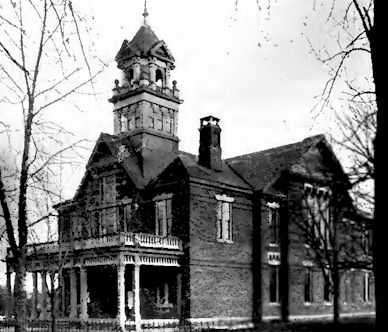|
Welcome
to Maryland American
History and Genealogy Project
we are in the process of
building new State and County pages for the states where
the coordinator has moved on to other projects. Prince
George County is looking for a new Coordinator would you
be interested? If so please contact
Webmaster.
Many of the present coordinators are always willing to give help and
suggestions to newcomers, you can learn, I did and that was after 60!!
Read our
About Page and see what our requirements are,
pretty easy!


Court House at Upper
Marlboro
Prince George's County, named in honor of Prince George
of Denmark, husband of Queen Anne, was formed in 1695,
having been originally a part of Charles. The seat of
local government was first established at Mount Calvert,
on the Patuxent River, but it was soon removed to Upper
Marlboro (named for the Duke of Marlborough in 1706).
The number of white children of school age is 6,175, and
the number of colored children, 5,179.
Prince George's is one of the most progressive and
prosperous counties of the State. Its growth is promoted
largely by its proximity to the national capital. The
resources of the county are mainly agricultural. In the
upper section, bordering upon the District of Columbia,
trucking is followed to a large extent. In the middle
and southern section's corn, wheat and tobacco are
cultivated, the last named on an extensive scale,
forming the staple product. The annual output of the
county is larger than that of any other of the
tobacco-growing counties. The principal towns are Upper
Marlboro, Laurel, Hyattsville, Bladensburg, Forestville
and Woodville. At Laurel there are cotton duck mills,
and a cereal mill has recently been established at
Hyattsville.
Bladensburg has the distinction of having been the scene
of one of the most significant battles of the War of
1812, and of many noted duels. The academy at Upper
Marlboro, established in 1835, is managed by a board of
seven trustees, and has always had for its principal a
capable teacher of the classics. Many persons who
attained eminence in public and professional life were
educated at this school. Even in colonial time. Prince
George's County was conspicuous for being the home of
cultured and educated people; and as early as 1745 Rev.
Dr. Eversfield, Rector of St. Paul's parish, established
a private school near his residence, which he continued
until his death, in 1780. He taught Greek and Latin and
furnished pupils with board at $53 per annum. The
Maryland Agricultural College is in this county.
The area of Prince George's is 480 square miles, and its
railroads are the Baltimore and Ohio, Baltimore and
Potomac, Pope's Creek, and Chesapeake Beach lines. Back
in the thirties the "Patuxent Manufacturing Company" was
incorporated and established the present cotton mill at
Laurel, the old name of the town being "Laurel Factory."
The iron industry in Prince George's dates back over a
century. The Snowdens, among the original settlers of
the county, established furnaces at various points in
southern Maryland. The Patuxent Furnace and Forge was
long a notable industry. The only iron works now in
operation in the county, or in rural Maryland, is the
Muirkirk Furnace, on the Baltimore and Ohio Railroad, at
Muirkirk. It was erected in 1847 by Andrew and Elias
Ellicott and modeled after a furnace at Muirkirk,
Scotland. The population of Laurel is 2,079,
Hyattsville, 1,222.
Online Here or Other Sites
Maryland
AHGP

Source: History of Maryland, by
L. Magruder Passano, Wm. J.C. Dulany Company, 1901.
|



